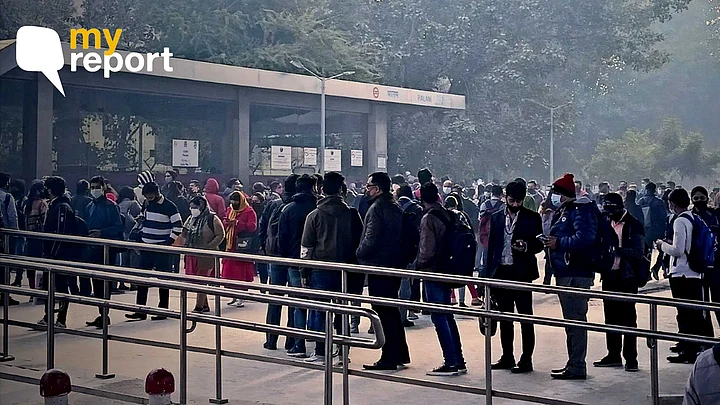The recent announcement by the Delhi govenment came as a relief for many of us. Especially for the people who had to wait in those long queues outside the metro station after a long day's work.
My experience was somewhat simliar. I travelled from Palam to NSIC Okhla on Monday, 3 January, and it took me more than half an hour just to enter the metro station.
It was the first Monday of 2022. And I thought of making a fresh start to the new year by meeting everyone at the office. But that optimism quickly went from being all happy to sulking when I saw serpentine queues at my usual metro station.
At the time, a yellow alert had been imposed in the national capital, which meant only 50 percent seating capacity will be allowed in Delhi Metro.
Even though CISF personnel were guarding and monitoring, the queue to get inside the Palam Metro station was long.
A person who was traveling on 31 December said it took him more than an hour to enter the station.
On checking social media, I noted that there were some people who were complaining and tagging relevant authorities.
For a moment it felt, the common man has been left to fend for themselves. Tagging authorities on social media for help didn't really help us either.
To my surprise, after about 15 minutes the queue started moving and fairly quickly. Along the way, I saw people recording videos of the line and sending them across to their friends.
COVID Protocols Should Be Followed First
As soon as I was about to get in the station, I was stopped by an official asking to wait as one batch was already full to its capacity.
I waited further, my waiting time kept increasing and so was the frustration of the people behind me. People started getting angry and calling out the authorities for such a move.
After a while, the next batch of people were sent in. After security check, I went to the platform and saw tons of people waiting to get inside the metro. I couldn't get in the first two metros. But somehow managed to get in the third one.
I was shocked to see the number of people inside the coach. Social distancing was not being followed, and all passengers were standing. This was contrary to the rules, which said that all passengers could only sit and travel.
To me, it was extremely shocking how there was nobody to monitor the COVID protocols. There was no one to check if people were wearing masks and if social distancing was being followed.
Before taking such drastic steps such as cutting down the capacity by 50 percent, the authorities should focus on monitoring the basic rules that need to be followed at the station.
At Hauz Khas station, many people got out, but many more got in, and within seconds, the coach was full. Some people tried maintaining social distance but were left with no option but to step out on the next station.
Finally, my destination station, Okhla NSIC came and I quickly exited the station. Relieved, I was finally able to take a breath.
I'm glad that I will have to work from home now and I do not have to travel everyday but I hope with 100 percent capacity being allowed now, it will save all the commuters from waiting for hours outside the station.
(All 'My Report' branded stories are submitted by citizen journalists to The Quint. Though The Quint inquires into the claims/allegations from all parties before publishing, the report and the views expressed above are the citizen journalist's own. The Quint neither endorses, nor is responsible for the same.)
(At The Quint, we question everything. Play an active role in shaping our journalism by becoming a member today.)
